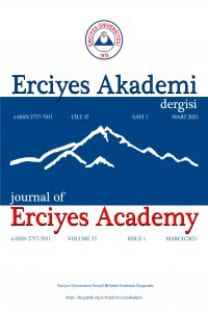TINI ANALİZLERİNDE KULLANILAN ANALOJİK ÖLÇÜTLER
Tını kavramı müzik teknolojisi kapsamında ve müzik prodüksiyonunun her aşamasında değerlendirilen ve ifade edilmeye çalışılan bir olgudur. Ses kaynağından elde edilen sinyallerin dalga boyu, şiddeti ve genliği, zarf yapısı gibi özellikleri tınıya etki etmekte ve fiziksel olarak açıklanabilmektedir. Tını kavramı içinde yer alan tonal kalite ve ses rengi gibi olgular ise psikoakustik bir değerlendirmede ne şekilde ifade edileceği kaotik bir süreç meydana getirmiştir. Ses rengi ve kalitesini tanımlanırken kullanılan; yumuşak, zengin, örtülü, açık, donuk, parlak, karanlık, tiz, pes, ızgara vb. çok sayıda ifade kullanlmıştır. Bu bağlamda müzik teorisyenleri bu karmaşayı daha anlaşılır hale getirme çabaları ve multidisipliner bir çalışma doğrultusunda analojik yaklaşımları içeren ölçütler geliştirmiştir. Aynı zamanda teorisyenler, spektogram kullanılarak yapılan ses sinyali analizlerinde elde edilen görüntünün analojik olarak analiz ve değerlendirme yapılabilecek yaklaşımlar ortaya koymuşlardır. Bu çalışma, nitel araştırma yöntemleri ve literatür taraması sonucunda elde edilen ve ulaşılabilen, tını kavramının analiz edilebilmesi için geliştirilen Cogan, Blake ve Lawengood’un analojik yaklaşımlarını incelemiş ve tını ile ilgili tarihsel spektogram analizi yaklaşımlarının bir sentezini ortaya konmuştur.
Anahtar Kelimeler:
Tını, Analiz, Müzik, Müzik teknolojisi
ANALOGICAL MEASUREMENTS USED IN TIMBRE ANALYSIS
The concept of timbre is a phenomenon that is evaluated and tried to be expressed within the scope of music technology and at every stage of music production. The wavelength, intensity and amplitude of the signals obtained from the sound source, properties such as the envelope structure affect the timbre and can be explained physically. Phenomena such as tonal quality and tonal color, which are included in the concept of timbre, have created a chaotic process how to express them in a psychoacoustic evaluation. Used when defining sound color and quality; soft, rich, veiled, light, dull, bright, dark, treble, low, grating, etc. Many expressions are used. In this context, music theorists tried to make this confusion more understandable and developed criteria that included analogical approaches in line with a multidisciplinary study. At the same time, theorists have revealed that the image obtained in audio signal analyzes using spectrograms are approaches that can be analysed and evaluated. This study examines the analogical approaches of Cogan, Blake & Lavengood, which were developed to analyze the concept of timbre, which were obtained and accessible as a result of qualitative research methods and literature review, and a synthesis of historical spectrogram analysis approaches related to timbre was presented.
Keywords:
Timbre, Analysis, Music, Music Technology,
___
- Allison, D. (1999). Structuralism. İçinde R. Audi (Ed.), The Cambridge dictionary of philosophy (Second Edition) (ss. 882-884). Cambridge University Press.
- Bal,N. P., Murat, M., & Erkan, B. (2020). Soyut düşünme becerileri açısından hikâyeler üzerinde analojik düşünme. The Journal of International Education Science, 25(7), 29-55.
- Bartlett, B., & Bartlett, J., (2009). Practical recording techniques. Focal Press.
- Blake, D. (2012). Timbre as differentiation in Indie music. Music Theory Online a Journal of the Society for Music Theory, 2(18),1-18.
- Cogan, R. & Escot, P. (1976). Sonic design: The nature of sound and music. Prentice-Hall Inc.
- Cogan, R. (1984). New images of musical sound. Harvard University Press.
- d’Escrivan, J. (2012). Music technology. Cambridge University Press.
- De Vale, S.C. (1985). Prolegomena to a study of harp and voice sounds in Uganda: A graphic system for the notation of texture. In Selected Reports in Ethnomusicology, 5, 250–281.
- Fales, C. (2002). The paradox of timbre. Ethnomusicology, 46(1), 56–95.
- Fischer, O. (2019). Analogy in language and linguistics. Oxford University Press.
- Gallagher, M. (2009). The music tech dictionary: A glossary of audio-related terms and technologies. Course Technology.
- Herdman, E. A. (2006). Derleme makale yazımında, konferans ve bildiri sunumu hazırlamada pratik bilgiler (Çev. Z. Dörtbudak). Hemşirelikte Eğitim ve Araştırma Dergisi, 3(1), 2-4.
- Hosken, D. (2011). An introduction to music technology. Routledge.
- Howard, D. M., & Angus, A. S. J. (2017). Acoustics and psychoacoustics. Routledge.
- Huber, D. M., & Runstein, R. E. (2018). Modern Recording Techniques. Focal Press.
- Jakobson, R. & Waugh, L. (1987). The sound shape of language. Mouton de Gruyter.
- Jensen, K. (2002). The timbre model. The Journal of the Acoustical Society of America, 112, 2238-2238.
- Krumhansl C. L. (1989). Why is musical timbre so hard to understand? In Structure and Perception of Electroacoustic. İçinde Nielzén S. & Olsson O. (Eds). Sound and Music, (ss. 43–53). Elsevier.
- Lavengood, M. (2017). A new approach to the analysis of timbre. City University of New York.
- LeBrecht, J. & Kaye, D. (2013). Sound and music for the theatre. Focal Press.
- Rajagopalan, K. (2011). Structuralism. İçinde P. Stranzy (Ed.), Encyclopedia of linguistics, (ss. 1041 – 1042). Taylor & Francis Group.
- Savage, S. (2011). The art of digital audio recording. Oxford University Press.
- Schroder, C. (2011). The book of audacity. No Starch Press.
- Slawson, W. (1981). The color of sound: A theoretical study in musical timbre. Music Theory Spectrum, 3(1), 132–141. https://doi.org/10.2307/746139
- Trubetzkoy, N. S. (1969). Principles of phonology. University of California Press.
- Yayın Aralığı: Yılda 4 Sayı
- Başlangıç: 1987
- Yayıncı: Erciyes Üniversitesi
Sayıdaki Diğer Makaleler
TARİHSEL ÇERÇEVEDE TÜRKİYE-SUUDİ ARABİSTAN İLİŞKİLERİ VE DIŞ POLİTİKAYA YANSIMASI
Hakkı BÜYÜKBAŞ, Ruveyda GÖRCÜER
İBRAHİM KALIN’IN MODERN BATI MEDENİYETİ TASAVVURU
HAFIZLIK EĞİTİMİNDE BİLİŞSEL HAZIRBULUNUŞLUK
TÜRKİYE’DE BAĞLAMA İLE İLGİLİ YAPILAN LİSANSÜSTÜ ÇALIŞMALARIN İNCELENMESİ
DİN ADINA DÜNYADAN VAZGEÇMEK: ORTA ÇAĞ FRANSA’SINDA RECLUS(E) OLGUSU
ÖĞRETMEN ADAYLARININ SOSYAL BECERİ ÖĞRETİMİNDE KIBRIS MASALLARININ KULLANIMINA YÖNELİK GÖRÜŞLERİ
GURBET KUŞLARI FİLM AFİŞİNİN GÖÇ OLGUSU BAĞLAMINDA GÖSTERGEBİLİMSEL ÇÖZÜMLENMESİ
